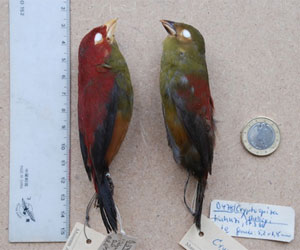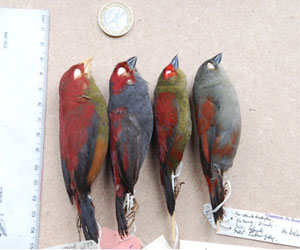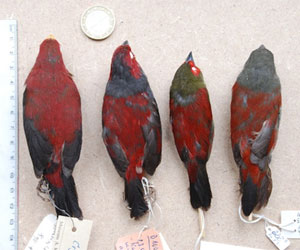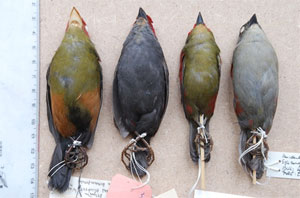|
||||||||
 |
||||||||
|
||||||||
R.F.C.G. News
|
The beak of the finch - Impressions from two
Shelley's crimsonwing finch (Cryptospiza shelleyi) skins at the
Alexander König Museum Bonn, Germany I visited the ornithological section of the Natural History Museum "Alexander König" in Bonn to take photographs of two skin specimens of Cryptospiza shelleyi that I knew were present in one of the most comprehensive bird skin collections world-wide. What was my motivation? Having read about this elusive bird at the RFCG homepage and blog, I eventually wanted to see the bird with my own eyes and hold it in my hands. Of course, a living bird would be much more thrilling, but knowing that this is something to fancy for the future this was a compromise for the presence. Apart from these feelings of a finch enthusiast, it was scientific curiosity that urged me to see these museum specimens: I always felt uncomfortable when looking at the two known fotos of Shelley's (the one taken by the www.gorilla.org-group in 2008 and the other published in 1974 in the Zaire bird book by Lippens & Wille) and at drawings in books, such as in the "Handbook of the Birds of the World" (HBW) Vol. 15, in "Birds of Africa" Vol. 7, or in "Finches & Sparrows"(by Clement, Harris, and Davis). They all look a bit different in terms of colour and habitus. For instance, in HBW, the colours are much lighter than in Birds of Africa. Which one is more realistic? Looking at the gorilla.org-foto, which seems to be the best quality picture of a living bird that we have in our hands, it looks as if the lighter drawing in HBW might capture it more realistically. But we all know that fotos can be misleading because a large number of possible combinations of environmental influences (in particular intensity of light) and camera settings can produce significantly different impressions of the bird. By looking at the museum skins, I therefore hoped to get a more unbiased impression of Shelley's plumage colour and to compare it to the other crimsonwing finch species. I had previously written in the RFCG blog that when comparing the four Cryptospiza species, Shelley's looked like a phenotypic outlier to me. If this was true and if it was reflected in the genetic relatedness to the other three species, one might also speculate about possible differences in life style and habitat requirements. This might be an interesting step towards identifying the factors responsible for Shelley's apparent decline and the reason why C. reichenovii and C. jacksoni, who share their habitat with Shelley's, seem to be doing fine under the same environmental influences. The two specimens (1,1) at the Bonn museum were collected 45 years ago by Dr. Peter Kunkel, a German ornithologist who was the director of a research institute in the Kivu highlands (Dem. Rep. Congo) from the 1960s to the beginning 1970s. Besides the two Shelley's crimsonwing finches, the collection holds a considerable number of C. reichenovii and C. salvadorii, as well as a few specimens of C. jacksoni. The Shelley's pair was obviously collected at Mt. Kahuzi, located southwest of the Virunga and Bwindi Impenetrable Forest National Parks in the Eastern part of the DR Congo. The area was converted into a national park (Kahuzi-Biéga National Parc) in 1970.
Kahuzi, 20.04.1966, 2300 m
Kahuzi, 17.03.1966 Overall appearance of the skins Compared to fotos of the Durban museum specimens shown on the RFCG
website, the Bonn specimens appear to be in a less good condition,
in particular the female (Figure 1). The museum is planning to subject
them to restauration.
My overall impression was that the colour of the birds is darker
than shown in HBW, on the Gorilla.org- foto and possibly also darker/less
bright than the Durban specimens. It seemed to be closer to the
drawing in Birds of Africa and Finches & Sparrows. It is unclear
whether the colour of the skins might have changed over the past
45 years. However, the colour of the skins of C. reichenovii and
C. salvadorii, which were stored under the same conditions and which
have a similar age, appeared completely natural to me. In their
case, I can compare to living birds, as I have seen a number of
both species which used to be quite common in aviculture until the
EU import ban of 2007. From the tags on the skins, one can assume that Dr. Kunkel kept the birds for a couple of days (male) to several weeks (female). Unfortunately, although Dr. Kunkel published about his observations on a regular basis during the 1960s, I am not aware of any publication, fotos or else about the Shelley's finches that he kept. I am currently trying to make contact with Dr. Kunkel. Shelleys crimsonwing finch in visual comparison to the other Cryptospiza species First of all, please note that the skin sizes do not necessarily
reflect the true size of the birds because of differences in skin
preparation. The C. reichenovii specimen depicted in Fig. 2-4 is
certainly too small compared to the other species. According to
the literature, Shelley's is supposed to be the largest species
of the genus (13 cm length), followed by C. jacksoni (11 cm) and
C. reichenovii and C. salvadorii (both 10-11 cm).
Differences in beak size and shape The most surprising observation to me was the size and shape of
Shelley's beak. The beak appears to be much larger than the ones
of Jackson's and especially Reichenov's and Salvadori's. This becomes
very obvious in the ventral view (Fig. 4) where I noticed how broad
(at the base) the beak is compared to the other species. If you
compare to Jackson's which is of similar body size, the difference
is quite pronounced and does not seem to be simply proportional
to the relatively small size difference. In C. reichenovii, the
beak appears much more pointed. It is clear that the number of Shelleys that are available for beak measurements is very limited and may prevent reliable conclusions that can be drawn from these data. At least in Durban, there is another pair of Shelley's where the beak size could be measured. Is the RFCG aware of other natural history museums that might have Shelley's skins in their collections?
Sven Cichon, Bonn, July 2011
Please refer to the RFCG Blog site on rarefinch.wordpress.com for the very latest news . The RFCG Blog was activated in September 2010 and is updated approximately 2 to 3 times a month.
Rare Finch Conservation Group ( RFCG ) progress report June 2009 to July 2010 Searching for Shelley's Crimsonwing finches amongst Africa's Mountain Gorilla's
The RFCG is extremely grateful to the Hans Hoheisen Charitable Trust who provided most of the funding required for this very important phase of the project .The in situ field work by the RFCG has, for the moment , been completed in the Bwindi Impenetrable National Park ( BINP ). This tropical rainforest park is situated in South Western Uganda and covers an area of approximately 330 square kilometres. ( By way of size comparison the Kruger National Park in South Africa is approximately 18,000 square kilometres ) The BINP is designated as a UNESCO world heritage sight, the forest is considered as one of the richest ecosystems in Africa. The park is only accessible on foot and is one of the last two remaining strongholds for the threatened Mountain Gorilla's( Gorilla beringei beringei ) , with an estimated population of 340 of the worlds last remaining 600 odd Mountain Gorilla's residing in the Bwindi Impenetrable Forest. In addition to the gorillas the park provides habitat for some 120 mammal species and 346 bird species ( 44 finch species ) The altitude in the park varies between 1190 m and 2607 m above sea level, although 60 percent of the park has an elevation of greater than 2000 metres. The parks diversity in species is partly attributable to the large variations in altitude along with the diverse habitat types which have evolved due to the extreme age of the area. As access to the area is on foot only it has been due to the efforts of the RFCG field team led by Benson Bumutura that we have managed to access and catalogue the species which we have thus far netted. During the field work we have endeavoured to cover as wide a spectrum of the ecosystems within the park as possible, and as can be imagined given the topography of the area this has at times been a huge challenge for our field team. The RFCG team, with permission from the Ugandan Wildlife Authority
as well as the Ugandan National Council for Science and Technology,
has been deployed to mist net within the various identified areas,
and make observations pertaining to the species, gender, location,
and time of capture. All species were also photographed. During the work in the BINP area, we have consistently encountered two of the four crimsonwing finch species, the Dusky crimsonwing(Crytospiza jacksoni) and the Red faced crimsonwing (Cryptospiza reichenovii) with very sporadic reports of the Abysinnian crimsonwing(Cryptospiza salvadorii), but to date none of our targeted species the elusive Shelley's Crimsonwing ( Cryptospiza shelleyi ). All captured crimsonwings are banded by the team, and the details of the specimen are recorded along with the ring numbers. This data ,when the bird is renetted , allows us to establish how much movement occurs by any given individual within the species. Currently the technology to monitor, by means of radio telemetry is prohibitively expensive and all indications are that given the nature of the terrain in which we are operating this method would not be successful and also, we do not possess sufficient data on this means of tracking to state unequivocally that such telemetry equipment does not hamper the bird in any way and thus making it more vulnerable to predation. All field requests for equipment and supplies etc. plus daily operational
matters are managed by means of cellular communications between
Benson in Uganda and RFCG directors Eelco Meyjes ( Operations )
and Simon Espley ( Strategy ) in South Africa. All field work data including information sheets, photographs etc. pertaining to the crimsonwing species research are filed and sent to the RFCG, through the kind facilitation of the Institute of Tropical Forest Conservation ( ITFC ) who are based in Ruhija in the South Eastern part of the Bwindi Impenetrable Forest The RFCG receives monthly postal reports from Uganda and the field data is then collated and formatted by Professor Ernst Kruger, and the RFCG website is updated by William van Rijn and all finances are managed by Mark Stewart. In conclusion given the nature of the terrain and the limited resources at our disposal, the group has managed to build through these endeavours a foundation of practical experience that we would not have been able to acquire by any other means. Despite the extensive efforts in this regard, we have as yet been unable to fulfil our primary goal for this initial project and that would be the successful netting, photography and census of a population of Shelley's crimsonwing finches. The RFCG after much consideration believe we have by the means at our disposal done all we can , for the moment, within Bwindi to find this species. Obviously there now exists a far greater degree of awareness of the rarity of the Shelley's , probably than ever before , both in the Bwindi area among the professional bird guides, who are in the field almost daily with international birders, as well as amongst finch enthusiasts throughout the world. The RFCG in February 2010 decided to relocate our field research team to the Mgahinga Gorilla National Park , which is in the very southern part of Uganda , the park is contiguous with the Virunga National Park in the Democratic Republic of the Congo to the west and the Volcanoes National Park in the Republic of Rwanda to the south. Benson our head field researcher has a confirmed sighting of the Shelley's in this park, prior to him being part of the RFCG field project, and hence we are filled with optimism for our new venture in this area. Finding this finch remains our first goal, but we do not want to lose sight of the fact that the RFCG was established, in 2005, in an attempt to assisting in the plight of all rare and endangered finch species and we continue to direct our efforts towards this goal. The Rare Finch Conservation Group is a registered non profit organisation. Should you wish to become a donor contributions can be made to : The Rare Finch Conservation Group . Nedbank. Account number 1933 198885, SWIFT NEDSZAJj Sandown Branch 193 305 . South Africa . All contributions will be acknowledged on the RFCG website and in Africa Birds and Birding magazine ( official media sponsors to the project ) For more information contact : Eelco Meyjes editor@avitalk.co.za.
|
Contact Rare Finch Conservation Group
e-mail: editor@avitalk.co.za | postal:
P.O.Box 782403, Sandton, 2146, South Africa
Copyright © 2006-2025 Rare Finch Conservation
Group in all materials not expressly attributed to another. All rights reserved.
Web Development www.simplywebs.co.za



